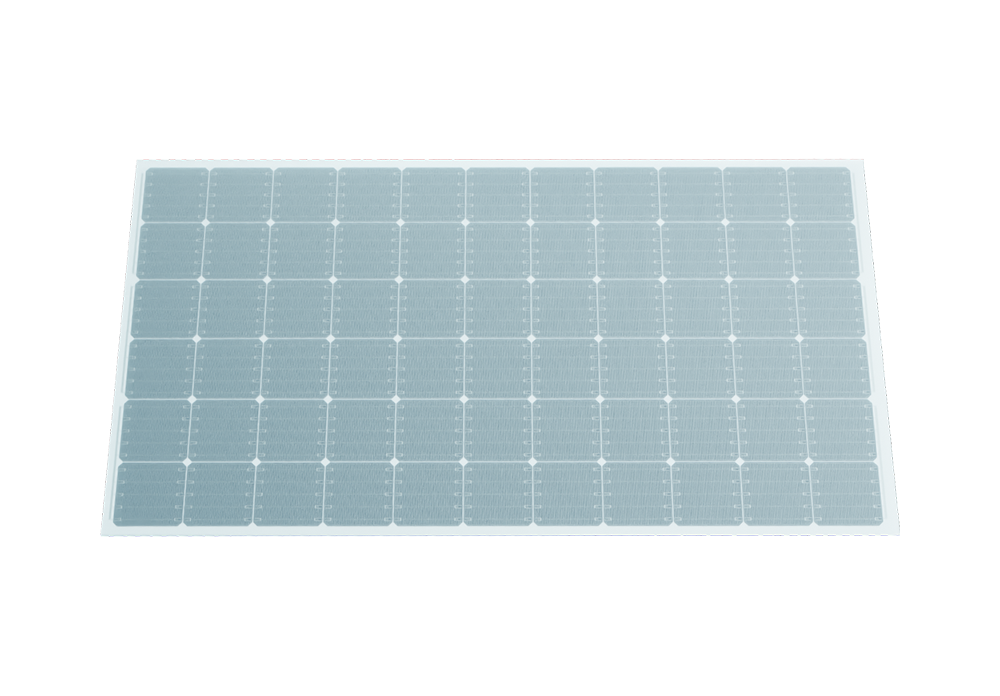Best use of solar energy
Glass-to-glass solar modules do not contain the weakest link of photovoltaic panels – that is, layers of plastic. Instead, we use glass sheets with unique properties that ensure better light distribution and much longer life and resistance to external factors.
Solar
modules

Distinctive design,
exceptional features.
Non-flammability
FIBRAIN Energy solar modules are constructed from two sheets of safety tempered glass. This means that they are virtually 100% non-flammable, unlike traditional photovoltaic panels.
Efficiency guarantee
FIBRAIN Energy solar modules provide impressive efficiency – up to 8% more energy generated* compared to standard panels. Panel efficiency is guaranteed at 87% of the initial value after 30 years of use.
Resistance to mechanical loads
Protecting the module with sheets of tempered glass ensures a much longer service life and resistance to micro-cracks, caused, for example, by hail, which can affect the efficiency of the installation.
Protection and durability in one

Self-cleaning properties
Thanks to a suitable diffusion nanostructure, FIBRAIN Energy modules have self-cleaning properties. This lowers the maintenance costs of the installation and - above all - ensures greater efficiency of the installation, where more light simply enters.
Reduced dirt deposition on the glass surface
Increased energy production
Lower maintenance costs
8% more energy from the module
The anti-reflective (AR) layer used in FIBRAIN Energy modules allows them to absorb more light than traditional panels. This has been confirmed by relevant studies conducted by Fraunhofer SP Institute.


Frameless design, variety of colours available
Attractive and frameless design of FIBRAIN Energy's solar modules is available in matte and glossy finishes, in a range of RAL colors, which is particularly suitable for both modern and historic buildings.
Innovative technology
Photovoltaic modules consisting of 2 sheets of tempered glass can absorb significantly more heat. Such a solution clearly improves the energy production capabilities of the entire installation. Securing the module with reinforced glass panels ensures longer life and significantly improves the protection of photovoltaic cells from micro-cracks. The structure carries a higher static as well as dynamic load, and is properly completely resistant to the harmful effects of chemical agents, including ammonia and salt spray.

(front glass, 3 or 4 mm)
(rear glass, 3 or 4 mm)






Product comparison



Technical data
Matte PV panel
Parameters
Module
ASOL-320P-AR-DF-GG
Maximum power Pmax
320 Wp
Open circuit voltage Voc
40,14 V
Short circuit voltage Isc
9,89 A
Maximum power voltage Vmp
34,26 V
Maximum power current Imp
9,34 A
Power tolerance
-0/+5Wp
Light is infinite potential.
Light is an opportunity for growth.
Light is a better life.
Produce energy from each glass surface
Roofs and canopies
BIPV panels can be installed not only on typical pitched roofs, but also on flat roofs. The large surface area of the roof allows the panels to be installed in any direction to ensure the appropriate amount of energy is obtained.
Fascades
The use of photovoltaic systemsBIPV on the facade of a building, thanks to their large surface area, generate energy, thanks to which we can reduce building operating costs, such as lighting, heating, ventilation, air conditioning. On request, the panels can be painted in any color from the RAL palette.
Carports
One of the applications of PV panels can be photovoltaic canopies, which in addition to producing energy also create shade for people or vehicles. DAGLASS glass has the property of tight cleaning, so that organic impurities are removed by a special coating with the help of UV rays and rain.
Balcony
PV panels mounted on balcony railings will also allow individual consumers to obtain solar energy. Consequently, unrestricted and environmentally friendly energy will be utilized in households, thereby reducing the quantity of electricity sourced from the grid.
Power farms
Photovoltaic farms are the future. Our innovative glass maximizes the amount of energy harvested in many ways. The solar module’s glass-glass design allows for bilateral harvesting of solar energy – from the top, straight from the sun, and you can also control a portion of the solar radiation, which will reflect off the ground and reach the back of the module.
